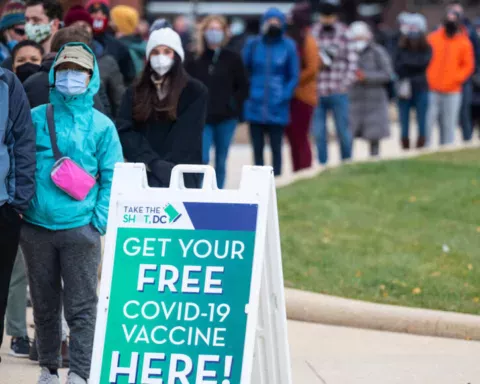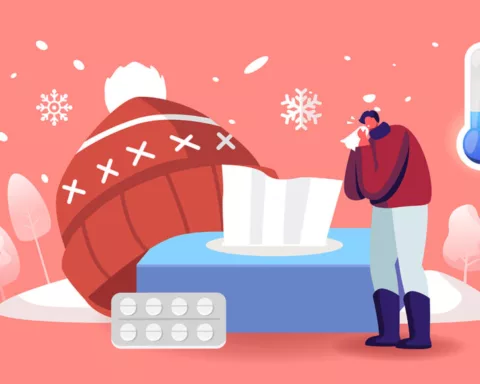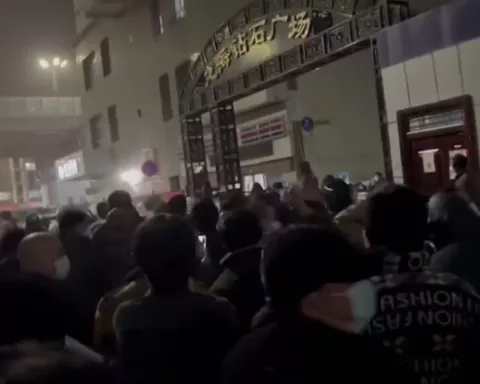These considerations are meant to supplement—not replace—any state, local, territorial, or tribal health and safety laws, rules, and regulations with which holiday gatherings must comply. When planning to host a holiday celebration, you should assess current COVID-19 levels in your community to determine whether to postpone, cancel, or limit the number of attendees.
Virus spread risk at holiday celebrations
Celebrating virtually or with members of your own household poses low risk for spread. In-person gatherings pose varying levels of risk. Event organizers and attendees should consider the risk of virus spread based on event size and use of mitigation strategies, as outlined in the Considerations for Events and Gatherings. There are several factors that contribute to the risk of getting infected or infecting others with the virus that causes COVID-19 at a holiday celebration. In combination, these factors will create various amounts of risk, so it is important to consider them individually and together:

- Community levels of COVID-19 – Higher levels of COVID-19 cases and community spread in the gathering location, as well as where attendees are coming from, increase the risk of infection and spread among attendees. Family and friends should consider the number and rate of COVID-19 cases in their community and in the community where they plan to celebrate when considering whether to host or attend a holiday celebration. Information on the number of cases in an area can be found on the area’s health department website.
- The location of the gathering – Indoor gatherings generally pose more risk than outdoor gatherings. Indoor gatherings with poor ventilation pose more risk than those with good ventilation, such as those with open windows or doors.
- The duration of the gathering – Gatherings that last longer pose more risk than shorter gatherings.
- The number of people at the gathering – Gatherings with more people pose more risk than gatherings with fewer people. CDC does not have a limit or recommend a specific number of attendees for gatherings. The size of a holiday gathering should be determined based on the ability to reduce or limit contact between attendees, the risk of spread between attendees, and state, local, territorial, or tribal health and safety laws, rules, and regulations.
- The locations attendees are traveling from – Gatherings with attendees who are traveling from different places pose a higher risk than gatherings with attendees who live in the same area. Higher levels of COVID-19 cases and community spread in the gathering location, or where attendees are coming from, increase the risk of infection and spread among attendees.
- The behaviors of attendees prior to the gathering – Gatherings with attendees who are not adhering to social distancing (staying at least 6 feet apart), mask wearing, hand washing, and other prevention behaviors pose more risk than gatherings with attendees who are engaging in these preventative behaviors.
- The behaviors of attendees during the gathering – Gatherings with more preventive measures in place, such as mask wearing, social distancing, and hand washing, pose less risk than gatherings where fewer or no preventive measures are being implemented.
General considerations for fall and winter holidays
Fall and winter celebrations, such as Rosh Hashanah, Yom Kippur, Halloween, Día de los Muertos, Navratri, Diwali, Thanksgiving, Día de la Virgen de Guadalupe, Hanukkah, Kwanzaa, Christmas, and New Year’s, typically include large gatherings of families and friends, crowded parties, and travel that may put people at increased risk for COVID-19.
Before you celebrate
Hosting a holiday gathering
If you will be hosting a celebration, follow CDC tips for hosting gatherings. Below are some additional considerations for hosting a holiday celebration:
- Host outdoor activities rather than indoor activities as much as possible. If hosting an outdoor event is not possible, and you choose to host an indoor event, avoid crowded, poorly ventilated, or fully enclosed indoor spaces.
- Increase ventilation by opening windows and doors to the extent that is safe and feasible based on the weather.
- Host activities with only people from your local area as much as possible.
- Limit numbers of attendees as much as possible.
- Provide updated information to your guests about any COVID-19 safety guidelines and steps in place to prevent the spread of the virus.
- Provide or encourage attendees to bring supplies to help you and others stay healthy. For example, extra masks (do not share or swap with others), hand sanitizer that contains at least 60% alcohol, and tissues.
- If you are planning in-person holiday gatherings with people outside of your household, consider asking all guests to strictly avoid contact with people outside of their households for 14 days before the gathering.
Attending a holiday gathering
If you will be attending a celebration that someone else is hosting, follow CDC Considerations for attending an event or gathering. Below are some additional considerations for attending an in-person holiday gathering:
- Outdoor activities are safer than indoor activities. If participating in an outdoor event is not possible, and you choose to attend an indoor event, avoid crowded, poorly ventilated, and fully enclosed indoor spaces. Increase ventilation by opening windows and doors to the extent that is safe and feasible based on the weather.
- Check with the event host, organizer, or event venue for updated information about any COVID-19 safety guidelines and if they have steps in place to prevent the spread of the virus.
- Bring supplies to help you and others stay healthy. For example, bring extra masks (do not share or swap with others), hand sanitizer that contains at least 60% alcohol, and tissues.
- If you are planning to attend in-person holiday gatherings with people outside of your household, consider strictly avoiding contact with people outside of your household for 14 days before the gathering.
Holiday travel
Traveling increases the chance of getting and spreading COVID-19. Staying home is the best way to protect yourself and others. Use information from the following webpages to decide whether to go on holiday travel:
If you decide to travel, follow these safety measures during your trip toprotect yourself and others from COVID-19:
- Wear a mask to keep your nose and mouth covered when in public places.
- Avoid close contact by staying at least 6 feet apart (about 2 arms’ length) from anyone who is not from your household.
- Wash your hands often with soap and water for at least 20 seconds or use hand sanitizer (with at least 60% alcohol).
- Avoid contact with anyone who is sick.
- Avoid touching your eyes, nose, and mouth.
Get your flu vaccine
Gatherings can contribute to the spread of other infectious diseases. Getting a flu vaccine is an essential part of protecting your health and your family’s health this season. September and October are good times to get vaccinated. However, flu vaccines are still useful any time during the flu season and can often be accessed into January or later.
During the celebration
Follow these tips to reduce your risk of being exposed to, getting, or spreading COVID-19 during the celebration:
Social distance and limit close contact
- Maintain a distance of at least 6 feet or more from people you don’t live with. Be particularly mindful in areas where it may harder to keep this distance, such as restrooms and eating areas.
- Avoid using restroom facilities at high traffic times, such as at the end of a public event.
- Avoid busy eating areas, such as restaurants during high volume mealtimes, if you plan to eat out at a restaurant.
- Minimize gestures that promote close contact. For example, do not shake hands, bump elbows, or give hugs. Instead wave and verbally greet others.
Wear masks
- Wear a mask at all times when around people who don’t live in your household to reduce the risk of spreading the virus.
- Avoid singing, chanting, or shouting, especially when not wearing a mask and within 6 feet of others.
Do not use costume masks in place of cloth masks
- Do not use a costume mask (such as for Halloween) as a substitute for a cloth mask unless it is made of two or more layers of breathable fabric that covers your mouth and nose and doesn’t leave gaps around your face.
- Do not wear a costume mask over a cloth mask because it can be dangerous if the costume mask makes it hard to breathe. Instead, consider using a Halloween-themed cloth mask.
Limit contact with commonly touched surfaces or shared items
- Clean and disinfect commonly touched surfaces and any shared items between use when feasible. Use EPA-approved disinfectantsexternal icon.
- Use touchless garbage cans if available. Use gloves when removing garbage bags or handling and disposing of trash. Wash hands after removing gloves.
Wash hands
- Wash your hands often with soap and water for at least 20 seconds, especially after you have been in a public place, or after blowing your nose, coughing, or sneezing. If soap and water are not readily available, use a hand sanitizer that contains at least 60% alcohol. Cover all surfaces of your hands and rub them together until they feel dry.
Keep safe around food and drinks
Currently, there is no evidence to suggest that handling food or eating is associated with directly spreading COVID-19. It is possible that a person can get COVID-19 by touching a surface or object, including food, food packaging, or utensils that have the virus on it and then touching their own mouth, nose, or possibly their eyes. However, this is not thought to be the main way that the virus is spread. Remember, it is always important to follow good hygiene to reduce the risk of illness from common foodborne germs.
- Make sure everyone washes their hands with soap and water for 20 seconds before and after preparing, serving, and eating food. Use hand sanitizer with at least 60% alcohol if soap and water are not available.
- Instead of potluck-style gatherings, encourage guests to bring food and drinks for themselves and for members of their own household only.
- Limit people going in and out of the areas where food is being prepared or handled, such as in the kitchen or around the grill, if possible.
- Wear a mask while preparing or serving food to others who don’t live in your household.
- If serving any food, consider having one person serve all the food so that multiple people are not handling the serving utensils.
- Use single-use options or identify one person to serve sharable items, like salad dressings, food containers, plates and utensils, and condiments.
- Avoid any self-serve food or drink options, such as buffets or buffet-style potlucks, salad bars, and condiment or drink stations. Use grab-and-go meal options, if available.
- If you choose to use any items that are reusable (e.g., seating covers, tablecloths, linen napkins), wash and disinfect them after the event.
- Look for healthy food and beverage options, such as fruits and vegetables, lean proteins, whole grains, and low or no-calorie beverages, at holiday gatherings to help maintain good health.
After the celebration
If you participated in higher risk activities or think that you may have been exposed during your celebration, take extra precautions (in addition the ones listed above) for 14 days after the event to protect others:
- Stay home as much as possible.
- Avoid being around people at increased risk for severe illness from COVID-19.
- Consider getting tested for COVID-19.
If you develop symptoms consistent with COVID-19, such as fever, cough, or shortness of breath, or if you test positive for COVID-19, immediately contact the host and others that attended the event or celebration that you attended. They may need to inform other attendees about their possible exposure to the virus. Contact your health care provider and follow the CDC-recommended steps for what to do if you become sick, and follow the public health recommendations for community-related exposure.
If you are waiting for your COVID-19 test results, stay home until you have a result, and follow CDC’s guidancepdf icon to help stop the spread of COVID-19.
If you have been diagnosed with COVID-19, a public health worker may contact you to check on your health and ask you who you have been in contact with and where you’ve spent time in order to identify and provide support to people (contacts) who may have been infected. Your information will be confidential. Learn more about what to expect with contact tracingpdf icon.
If you are notified that you were a close contact of someone who tested positive for COVID-19
- Stay home for 14 days from the last time you had contact with that person.
- Monitor for symptoms of coronavirus.
- Get information about COVID-19 testing if you feel sick.
Fall holiday celebrations
Rosh Hashanah, Yom Kippur, Halloween, Día de Los Muertos, Navratri, Diwali, and Thanksgiving will likely need to be different this fall to prevent the spread of the virus that causes COVID-19. Avoid activities that are higher risk for spread. Consider fun alternatives that pose lower risk of spreading the virus that causes COVID-19.






